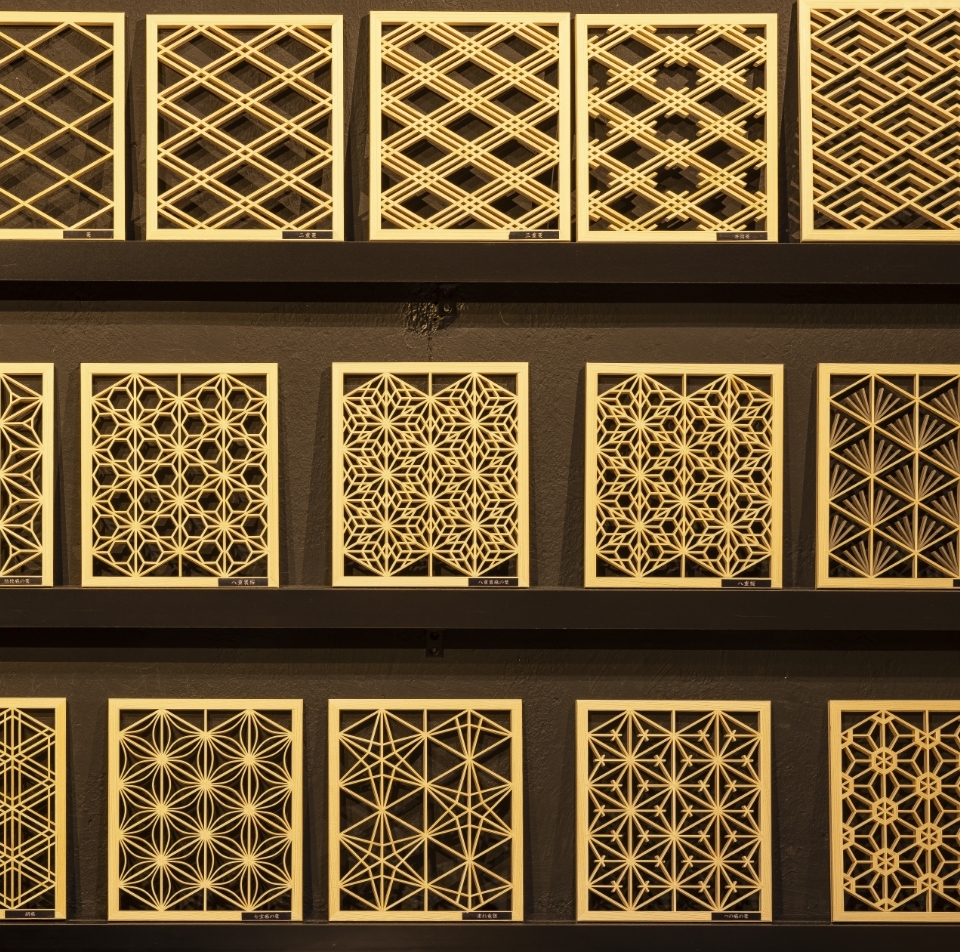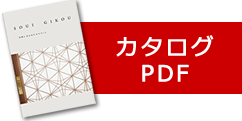
代表的な文様
-
三つ組手 mitsugumite
三つの組手が重なるため、 三つ組手と呼ばれています。組子においてはすべての良し悪しを決める大事な組手です。
-
籠目 kagome
五芒星が連続しているように見えることから魔除けの文様とされ、男性や子供の精神が浮遊するのを囲い止める意味があります。
-
麻の葉 asanoha
平安時代に仏教の尊像の衣服にも用いられており、古くから伝わる柄といわれています。日本人がこよなく愛した文様の一つです。
-
重ね竜胆 kasanerindou
竜胆の花をモチーフにした文様です。円が重なり合って見える特徴があり、和室にも洋室にも馴染む人気のある文様です。
-
胡麻 goma
胡麻は古来より長寿の薬として伝えられてきました。直線美が特徴的な胡麻には長寿と健康の願いが込められています。
-
つの麻の葉 tsunoasanoha
麻の葉の文様を派生させたつの麻の葉。雪の結晶のような文様で可愛らしさが感じられます。
-
桜 sakura
日本で最も愛される花の一つである桜。どことなく可愛さがあり女性から好まれる文様です。
-
七宝麻の葉 shippouasanoha
組子の中でも珍しい曲木を施した文様です。七宝と麻の葉を掛け合わせた特徴のある文様です。
-
変わり胡麻 kawarigoma
古典柄の胡麻を派生させた文様です。組み合わさると幾何学模様のような柄が浮かび上がります。
-
弁天亀甲 bentenkikkou
亀甲は亀の甲羅の形を模した文様を指します。弁天亀甲は六角模様の亀甲の外側に細かい三角形を取り巻くように配置します。
-
帝つなぎ mikadotsunagi
多角形が規則的に美しく連続で並ぶ文様は、繁栄・永遠の命を象徴するといわれています。
-
八重麻 yaeasa
八重とは多くが重なる事を表しています。組子の重なる部分が多く、熟練の技術が必要となる組子です。
-
二重麻の葉 nijyuasanoha
麻の葉が二重になっていることから、そこに込められた願いや意味合いがより強くなっているものとされています。
-
変わり麻の葉 kawariasanoha
麻の葉の文様を派生させ、中に三角の葉を入れてアレンジを加えた文様です。
-
桔梗麻の葉 kikyouasanoha
桔梗と麻の葉をモチーフとした文様です。桔梗と麻の葉には子供の健康・魔除け、永遠の愛という意味があります。
-
八重裏花 yaeurabana
日本で最も愛される花の一つである桜を用いた八重桜に、さらにあしらいを加えた文様です。
-
菱 hishi
幾何学的な模様でありながらルーツは水草の菱の葉で、繁殖力の強い特徴があることから子孫繁栄、無病息災を願う柄といわれています。
-
二重菱 futaebishi
二重菱とは、菱が二重になった文様です。菱は他の文様と組み合わされ発展し、平安時代には家紋としても用いられています。
-
三重菱 miebishi
三重菱は、菱形を三重に重ねた文様です。菱は紋章としても用いられており、衣類や家具にも施されています。
-
井筒菱 izutsubishi
昔の井戸の蓋を表した文様です。井桁とも表現します。菱組の中でも複雑で豪華な特徴ある文様です。
-
角麻 kakuasa
麻の葉と同じ日本を代表する文様です。亀甲ではなく角からなる図柄から角麻の葉と呼ばれています。
-
桐麻の葉 kiriasanoha
桐文様は高貴な紋章として、天下人や武家が好んだとされています。豪華なだけでなく、すっきりとした印象も与えてくれる文様です。
-
千本格子 senbonkoushi
細かく引き割った桟を無数に並べていることから千本格子と呼ばれています。繊細でナチュラルな直線美を感じ取れる直線組子です。
-
七宝 shippou
七宝は仏教の仏典において七つの宝を表し、金・銀・瑠璃・玻璃・しゃこ(貝)珊瑚・瑪瑙は縁起の良い宝づくしの意味が込められています。
-
青海波 seikaiha
穏やかに広がる海のように平穏な生活が続いて欲しいという願いが込められ、着物・帯などに使われる人気の文様です。
創意技巧オリジナル文様
-
松の葉 matsunoha
創意技巧オリジナル文様
創意技巧オリジナルの文様です。松はめでたい木として、正月に門松を立てて年神様を迎える習わしがあります。
-
創意桜 souisakura
創意技巧オリジナル文様
創意技巧オリジナルの桜文様です。桜に見立てた可愛らしい文様で、桜が散りゆく様を表現した組子です。
-
Shell
創意技巧オリジナル文様
貝殻の形をイメージし、組み合わせました
-
Dia
創意技巧オリジナル文様
組子の葉でダイヤを表現しました。
-
Millet
創意技巧オリジナル文様
ミレットのように真っ直ぐ咲く花をイメージしたデザインです。
-
Galet
創意技巧オリジナル文様
フランス語で石畳を意味するガレ。そんなイメージをデザインしました。
-
Dahlia
創意技巧オリジナル文様
ダリアの花のように華やかで麗しい姿を表現しました。
-
Cuore
創意技巧オリジナル文様
洋風のリビングにも馴染むデザインでクオーレ(心)を表現しました。
-
Jewel
創意技巧オリジナル文様
宝石を散りばめたようなデザインに仕上げています。
-
Quilt
創意技巧オリジナル文様
バッグに用いられているキルト加工した布を組子で表現しました。
-
Attrait
創意技巧オリジナル文様
フランス語で魅力という意味があるアトレ。魅力的に柄をデザインしました。
規格・サイズについて

- 材質
- 吉野桧源平材・吉野杉
- サイズ
- 幅900mm×高さ約2000mm×奥行15mm





































